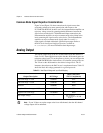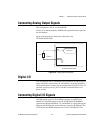
Chapter 2 Hardware Overview of the NI 78xxR
R Series Intelligent DAQ User Manual 2-16 ni.com
Common-Mode Signal Rejection Considerations
Figure 2-6 and Figure 2-9 show connections for signal sources that
are already referenced to some ground point with respect to the
NI 783xR/784xR/785xR. In these cases, the instrumentation amplifier can
reject any voltage caused by ground potential differences between the
signal source and the device. With differential input connections, the
instrumentation amplifier can reject common-mode noise pickup in the
leads connecting the signal sources to the device. The instrumentation
amplifier can reject common-mode signals when V+
in
and V–
in
(input signals) are both within their specified input ranges. Refer to
the NI R Series Intelligent DAQ Specifications, available at
ni.com/manuals, for more information about input ranges.
Analog Output
The bipolar output range of the NI 783xR/784xR/785xR AO channels is
fixed at ±10 V. Some applications require that the AO channels power on
to known voltage levels. To set the power-on levels, you can configure the
NI 783xR/784xR/785xR to load and run a VI when the system powers on.
The VI can set the AO channels to the desired voltage levels. The VI
interprets data written to the DAC in two’s complement format. Table 2-3
shows the ideal AO voltage generated for a given input code.
Note If your VI does not set the output value for an AO channel, then the AO channel
voltage output will be undefined.
Table 2-3. Ideal Output Voltage and Input Code Mapping
Output Description AO Voltage
Input Code (Hex)
(Two’s Complement)
Full-scale range –1 LSB 9.999695 7FFF
Full-scale range –2 LSB 9.999390 7FFE
Midscale 0.000000 0000
Negative full-scale range, +1 LSB –9.999695 8001
Negative full-scale range –10.000000 8000
Any output voltage —
AO Voltage
10.0 V
-------------------------------
32,768×


















